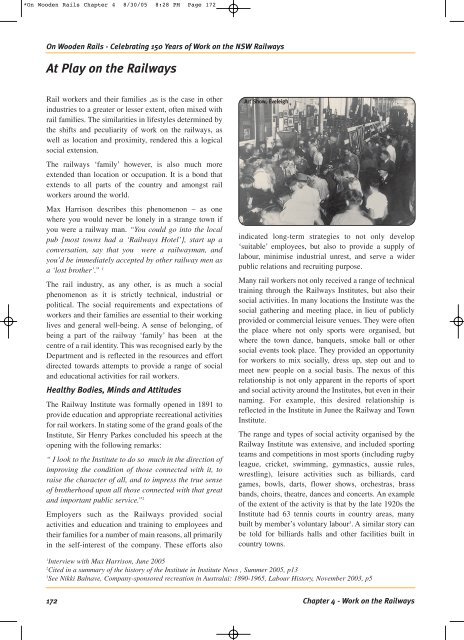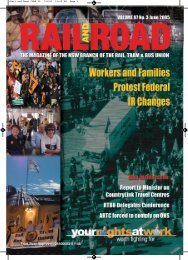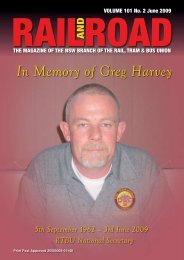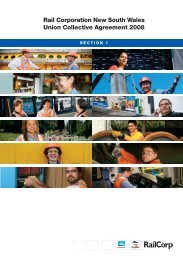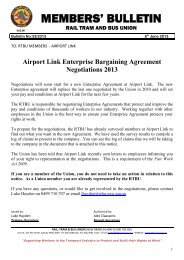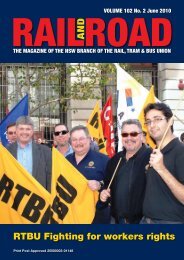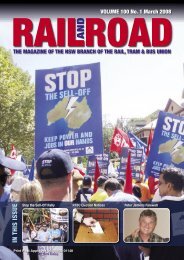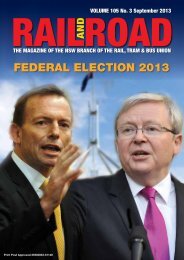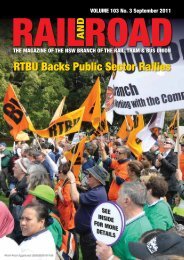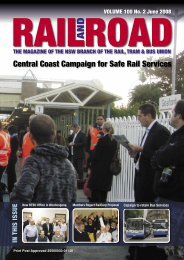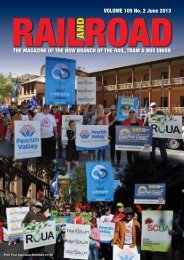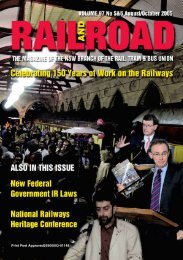Chapter 4 - Work on the Railways - Rail, Tram and Bus Union of NSW
Chapter 4 - Work on the Railways - Rail, Tram and Bus Union of NSW
Chapter 4 - Work on the Railways - Rail, Tram and Bus Union of NSW
You also want an ePaper? Increase the reach of your titles
YUMPU automatically turns print PDFs into web optimized ePapers that Google loves.
*On Wooden <strong>Rail</strong>s <str<strong>on</strong>g>Chapter</str<strong>on</strong>g> 4 8/30/05 8:28 PM Page 172<br />
On Wooden <strong>Rail</strong>s - Celebrating 150 Years <strong>of</strong> <str<strong>on</strong>g>Work</str<strong>on</strong>g> <strong>on</strong> <strong>the</strong> <strong>NSW</strong> <strong><strong>Rail</strong>ways</strong><br />
At Play <strong>on</strong> <strong>the</strong> <strong><strong>Rail</strong>ways</strong><br />
<strong>Rail</strong> workers <strong>and</strong> <strong>the</strong>ir families ,as is <strong>the</strong> case in o<strong>the</strong>r<br />
industries to a greater or lesser extent, <strong>of</strong>ten mixed with<br />
rail families. The similarities in lifestyles determined by<br />
<strong>the</strong> shifts <strong>and</strong> peculiarity <strong>of</strong> work <strong>on</strong> <strong>the</strong> railways, as<br />
well as locati<strong>on</strong> <strong>and</strong> proximity, rendered this a logical<br />
social extensi<strong>on</strong>.<br />
The railways ‘family’ however, is also much more<br />
extended than locati<strong>on</strong> or occupati<strong>on</strong>. It is a b<strong>on</strong>d that<br />
extends to all parts <strong>of</strong> <strong>the</strong> country <strong>and</strong> am<strong>on</strong>gst rail<br />
workers around <strong>the</strong> world.<br />
Max Harris<strong>on</strong> describes this phenomen<strong>on</strong> – as <strong>on</strong>e<br />
where you would never be l<strong>on</strong>ely in a strange town if<br />
you were a railway man. “You could go into <strong>the</strong> local<br />
pub [most towns had a ‘<strong><strong>Rail</strong>ways</strong> Hotel’], start up a<br />
c<strong>on</strong>versati<strong>on</strong>, say that you were a railwayman, <strong>and</strong><br />
you’d be immediately accepted by o<strong>the</strong>r railway men as<br />
a ‘lost bro<strong>the</strong>r’.” 1<br />
The rail industry, as any o<strong>the</strong>r, is as much a social<br />
phenomen<strong>on</strong> as it is strictly technical, industrial or<br />
political. The social requirements <strong>and</strong> expectati<strong>on</strong>s <strong>of</strong><br />
workers <strong>and</strong> <strong>the</strong>ir families are essential to <strong>the</strong>ir working<br />
lives <strong>and</strong> general well-being. A sense <strong>of</strong> bel<strong>on</strong>ging, <strong>of</strong><br />
being a part <strong>of</strong> <strong>the</strong> railway ‘family’ has been at <strong>the</strong><br />
centre <strong>of</strong> a rail identity. This was recognised early by <strong>the</strong><br />
Department <strong>and</strong> is reflected in <strong>the</strong> resources <strong>and</strong> effort<br />
directed towards attempts to provide a range <strong>of</strong> social<br />
<strong>and</strong> educati<strong>on</strong>al activities for rail workers.<br />
Healthy Bodies, Minds <strong>and</strong> Attitudes<br />
The <strong>Rail</strong>way Institute was formally opened in 1891 to<br />
provide educati<strong>on</strong> <strong>and</strong> appropriate recreati<strong>on</strong>al activities<br />
for rail workers. In stating some <strong>of</strong> <strong>the</strong> gr<strong>and</strong> goals <strong>of</strong> <strong>the</strong><br />
Institute, Sir Henry Parkes c<strong>on</strong>cluded his speech at <strong>the</strong><br />
opening with <strong>the</strong> following remarks:<br />
“ I look to <strong>the</strong> Institute to do so much in <strong>the</strong> directi<strong>on</strong> <strong>of</strong><br />
improving <strong>the</strong> c<strong>on</strong>diti<strong>on</strong> <strong>of</strong> those c<strong>on</strong>nected with it, to<br />
raise <strong>the</strong> character <strong>of</strong> all, <strong>and</strong> to impress <strong>the</strong> true sense<br />
<strong>of</strong> bro<strong>the</strong>rhood up<strong>on</strong> all those c<strong>on</strong>nected with that great<br />
<strong>and</strong> important public service.” 2<br />
Employers such as <strong>the</strong> <strong><strong>Rail</strong>ways</strong> provided social<br />
activities <strong>and</strong> educati<strong>on</strong> <strong>and</strong> training to employees <strong>and</strong><br />
<strong>the</strong>ir families for a number <strong>of</strong> main reas<strong>on</strong>s, all primarily<br />
in <strong>the</strong> self-interest <strong>of</strong> <strong>the</strong> company. These efforts also<br />
172<br />
Art Show, Eveleigh<br />
indicated l<strong>on</strong>g-term strategies to not <strong>on</strong>ly develop<br />
‘suitable’ employees, but also to provide a supply <strong>of</strong><br />
labour, minimise industrial unrest, <strong>and</strong> serve a wider<br />
public relati<strong>on</strong>s <strong>and</strong> recruiting purpose.<br />
Many rail workers not <strong>on</strong>ly received a range <strong>of</strong> technical<br />
training through <strong>the</strong> <strong><strong>Rail</strong>ways</strong> Institutes, but also <strong>the</strong>ir<br />
social activities. In many locati<strong>on</strong>s <strong>the</strong> Institute was <strong>the</strong><br />
social ga<strong>the</strong>ring <strong>and</strong> meeting place, in lieu <strong>of</strong> publicly<br />
provided or commercial leisure venues. They were <strong>of</strong>ten<br />
<strong>the</strong> place where not <strong>on</strong>ly sports were organised, but<br />
where <strong>the</strong> town dance, banquets, smoke ball or o<strong>the</strong>r<br />
social events took place. They provided an opportunity<br />
for workers to mix socially, dress up, step out <strong>and</strong> to<br />
meet new people <strong>on</strong> a social basis. The nexus <strong>of</strong> this<br />
relati<strong>on</strong>ship is not <strong>on</strong>ly apparent in <strong>the</strong> reports <strong>of</strong> sport<br />
<strong>and</strong> social activity around <strong>the</strong> Institutes, but even in <strong>the</strong>ir<br />
naming. For example, this desired relati<strong>on</strong>ship is<br />
reflected in <strong>the</strong> Institute in Junee <strong>the</strong> <strong>Rail</strong>way <strong>and</strong> Town<br />
Institute.<br />
The range <strong>and</strong> types <strong>of</strong> social activity organised by <strong>the</strong><br />
<strong>Rail</strong>way Institute was extensive, <strong>and</strong> included sporting<br />
teams <strong>and</strong> competiti<strong>on</strong>s in most sports (including rugby<br />
league, cricket, swimming, gymnastics, aussie rules,<br />
wrestling), leisure activities such as billiards, card<br />
games, bowls, darts, flower shows, orchestras, brass<br />
b<strong>and</strong>s, choirs, <strong>the</strong>atre, dances <strong>and</strong> c<strong>on</strong>certs. An example<br />
<strong>of</strong> <strong>the</strong> extent <strong>of</strong> <strong>the</strong> activity is that by <strong>the</strong> late 1920s <strong>the</strong><br />
Institute had 63 tennis courts in country areas, many<br />
built by member’s voluntary labour 3 . A similar story can<br />
be told for billiards halls <strong>and</strong> o<strong>the</strong>r facilities built in<br />
country towns.<br />
1 Interview with Max Harris<strong>on</strong>, June 2005<br />
2 Cited in a summary <strong>of</strong> <strong>the</strong> history <strong>of</strong> <strong>the</strong> Institute in Institute News , Summer 2005, p13<br />
3 See Nikki Balnave, Company-sp<strong>on</strong>sored recreati<strong>on</strong> in Australai: 1890-1965, Labour History, November 2003, p5<br />
<str<strong>on</strong>g>Chapter</str<strong>on</strong>g> 4 - <str<strong>on</strong>g>Work</str<strong>on</strong>g> <strong>on</strong> <strong>the</strong> <strong><strong>Rail</strong>ways</strong>


